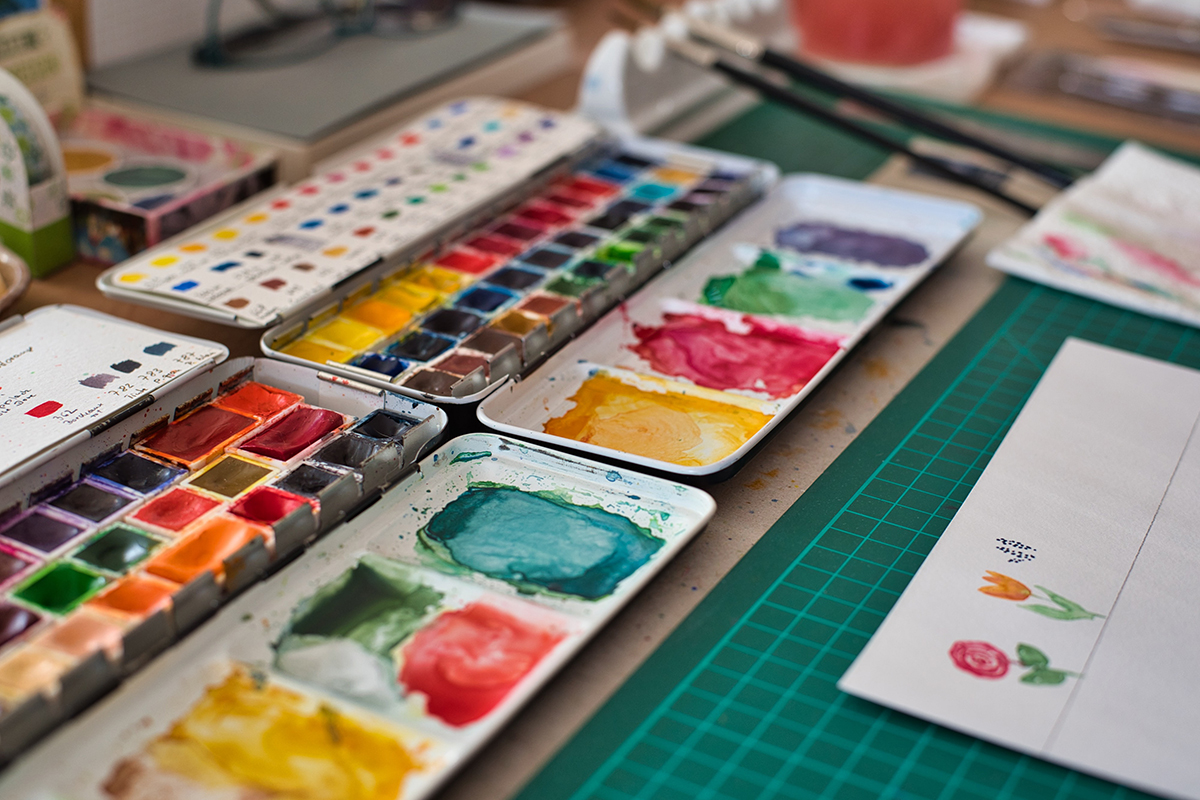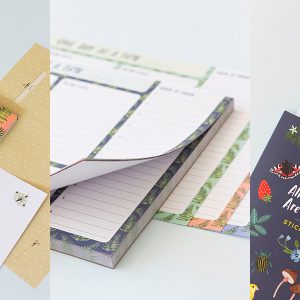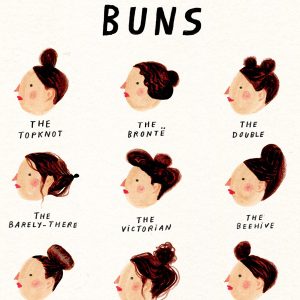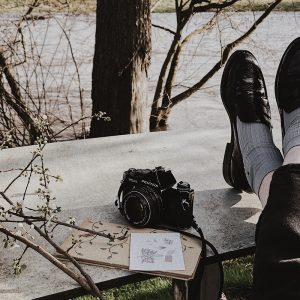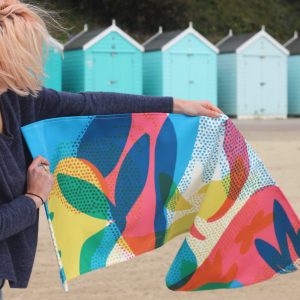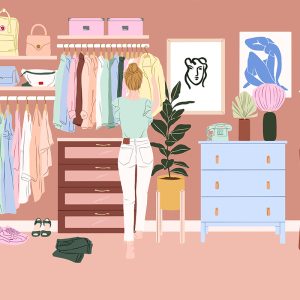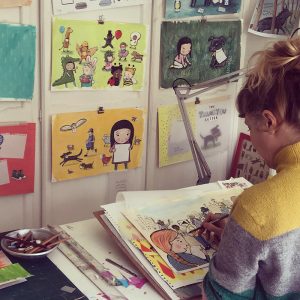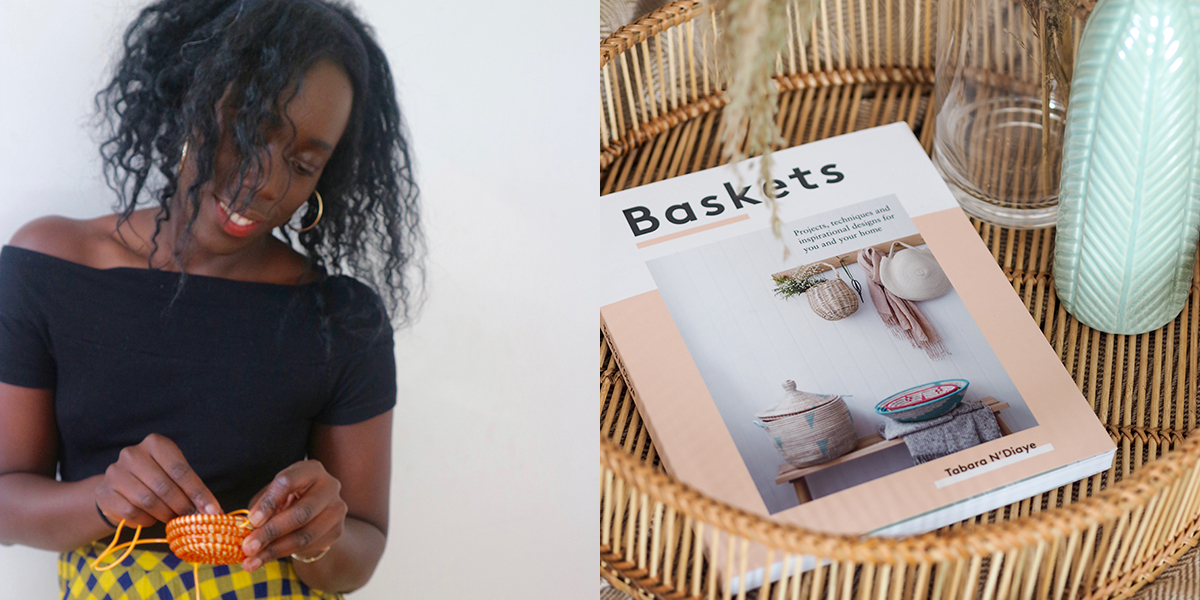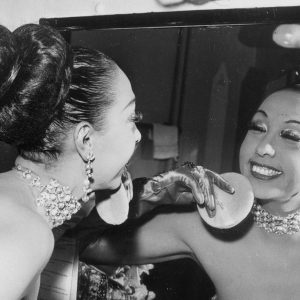Painting the same shape over and over again, each time in a different color: Caroline Buijs discovered how relaxing and educational that can be when she started doing color meditation.
While I, like most of us, was suddenly spending more time at home during the COVID-19 pandemic, I found how nice it is to draw lines on paper with a brush dipped in liquid watercolors or black ink. It gives me the same kind of peaceful feeling as swimming laps alone in a pool. Instead of counting my laps, like when I’m swimming, I now look at how the ink at the end of a line becomes lighter and lighter and how the thickness of the line is different every time. You can tell it is done by hand and it feels good to see and feel it.
Day and night
This is how it started: I was at an exhibition of the artist Louise Bourgeois, standing before a series of work with mainly thin horizontal and vertical lines that formed small squares. In the exhibition brochure, I read that Bourgeois worked on her drawings day and night: ‘She was suffering from insomnia, filling the dark hours. Geometric shapes made Louise feel calm and had a meditative effect: The predictability and repetition had a healing power, as did the gridded composition’. Just looking at her work made me feel calm. And what was even better, I became enthusiastic about doing it myself.
On my way home, I was already daydreaming about having my own studio with antique cupboards full of boxes of paint, brushes and colored chalk. But of course I could also get started without having my dream studio. Simply at my kitchen table, with materials I dug out of dusty corners: an old sketchbook, a few jars of liquid watercolor, ink and a brush. As I drew the stripes across the paper, I immediately understood the joy of it. The repetitive actions do indeed calm your mind and you do not have to think for a while.
Outside the box
But, to be honest, after a week, just drawing lines became boring. Luckily, a colleague told me about color meditation. I thought it would give a similar kind of peace, but with more shapes than lines alone—and with lots and lots of color. Artist and educator Lisa Solomon offers the class ‘Color Meditation Daily Practice’ on creativebug.com. She gives you a new painting assignment each day, for 30 days.
The assignment is very simple: Choose a shape, repeat it, change color and fill your page. Solomon makes it easy by choosing the color palette and shape per meditation for you. Circles, an arc, a triangle and so on—you don’t need to think or worry about what to do next. But Solomon also says you can let go of those parameters any time you want; she encourages you to step outside of that box that you set up for yourself.
Can’t Fail
After watching the promotional video, I decided to take the online course—the first one I have ever done in my life. Because I spend so much time at the computer, I’ve always stayed away from online classes—drawing and painting offline is already so much fun.
But this turned out to be incredibly fun, too. I couldn’t believe I had never done this before. Solomon is a cheerful person (and she wears sweaters and blouses in beautiful color combinations) and talks you through the assignments in an upbeat, but not too chirpy, way.
When she said things like ‘Let’s do another of those guys’ when she goes to pick out a color, it put me in a good mood. And when she finished the first lesson—in which you paint a series of colored dots—with, ‘Oh, I didn’t paint in a straight line in some of them, and I left some really awkward white space on the right hand side. But you know what, I don’t care’, I liked her even more.
At last, I didn’t have a strict teacher looking over my shoulder. What’s more, she showed me how I can silence the strict teacher in my own head. ‘But you know, I don’t care’ is now my mantra during the color meditations when I create splotches, mix rather ugly colors or knock over my jar of water.
Color meditation
Solomon started color meditation by chance, she tells me by email. ‘Whenever I bought a new paint,’ she writes, ‘I would test the colors by making color graphs and drawing dashes. After my daughter was born, I started meditating, but I found it difficult to sit still and keep it up. One day I had to try out some things for an art project with garlands.
I started painting garlands in my sketchbook by painting a lot of dots in a row. While I was doing this—one dot at a time and always carefully choosing the colors—I noticed how my body relaxed and my mind went blank. It felt like meditating. Now I think it is a lovely way to start or end my day.’
Every day
After a week, Solomon’s classes became something I really looked forward to. Sometimes I did four in one day, for example, on weekends. And sometimes I skipped a few days, but mostly I tried to make some time for it every day. It is crazy how that works.
Although I really love drawing and painting, I do it less than I would like to. During busy times in particular, it disappears into the background and Netflix wins, despite the fact that I know that drawing gives me more energy.
The longer I don’t draw, the harder it is to start again. These color meditations are also perfect for that. They are a kind of warm-up: exercises without any pressure. There is no risk of failure. Every lesson, Solomon explained what to do, so I could also let go of the ‘What will I paint now?’. Sometimes I only did a color meditation, sometimes I drew or painted something I felt like doing myself afterward—after all, I was already there.
It was a good way to trick myself: ‘No, you’re not going to draw, you’re just going to repeat some shapes’. If I continued drawing after that, all well and good. And if I didn’t, that was fine, too. There would be a new assignment another day.
Play
What I hadn’t realized beforehand is that, during these color meditations, I would learn a lot of new things about color. What a wonderful bonus. I realize how little I actually knew about color and how little I normally dared to experiment.
I have bought many beautiful pots of watercolor paint over the years, but how can I actually mix a color myself? I had no idea. Because I saw Solomon mix up everything in her videos and also saw that she’s not afraid to make a mucky brown color, I became more daring.
She makes her paint boxes very dirty and doesn’t seem to mind the colors in her palette getting mixed up—something I’m always worried about. Because I used to think it ruins the paint immediately.
So it turns out that I have (once again) been afraid of something without reason, because with some extra water you can just wash off the color that does not belong there. I’ve discovered what happens to color when you gradually add more white (‘tint’), or black (‘shade’). Everywhere, like Solomon, I now add a lot more water than I used to.
Practicing and experimenting
At first I copied what Solomon did exactly, but as the lessons progressed, I started choosing my own colors or deviating a bit from the shapes she proposed. And I realized once again that you only learn by doing, by practicing, by experimenting. The color meditations are so nice because they are a form of play. That’s really how it feels. Instead of working on the end result, I’m researching things.
Thanks to these regular meditations, drawing has become part of my daily life again. Instead of storing my material at the bottom of a cupboard, I now keep my drawing and painting supplies in a box and leave them out where I can see them. Everything to keep the drawing fires burning.
Challenges
I have also started noticing color more in my everyday life. I take photos of beautiful color combinations on the street, in nature, in books and in newspapers. Later, I try to copy these combinations. And when I do give in to Netflix, I marvel at the colors, for example, that team Angel and Minju use in their fashion creations in the Next in Fashion series.
I get to know the colors in my paint box better, I discover which are transparent and which are opaque. And I realize how conservative I’ve always been in my choice of colors: always something with earthy tones and blues. Solomon invited me to use the colors that I normally ignore.
This is how I discovered that despite my initial reservations about yellow, it can be beautiful, especially in particular combinations. And my conservative approach didn’t only apply to colors; it was also in my use of materials. I prefer to work with only three brushes (numbers 1, 2 and 3, how boring), but Solomon casually challenged me to use a very wide brush or a thicker brush.
I also noticed how nice it is to work with watercolor paper again. I always drew and painted in my Moleskin diary/scrapbook and I had forgotten that of course watercolor paper exists for a reason. The colors look better and the paper warps and wrinkles much less than other types of paper (although I think that is often beautiful, too).
No room for perfectionism
It is fascinating that something without purpose can be so fulfilling. Because I have no end goal, I choose colors, shapes and proportions much more intuitively now. And because I became more confident about all the colors and shapes, I feel like drawing and painting more often again. ‘Okay, I’m stopping’, Solomon says at the end of her videos, as she approves the result of her color meditation.
Often there is still room on her paper for more, but I would see her thinking that it’s enough, it’s good. There is no room for perfectionism during color meditation. How perfect is that?
Exercises
Painting the same shape over and over again in different colors: it relaxes your body and empties your mind. Use these exercises to try out color meditation. And the good thing is: you can’t go wrong.
What you need:
Paint
Good-quality watercolor paint with a lot of pigment gives you the best colors and doesn’t fade as quickly. That doesn’t mean, however, that you can’t do these exercises with any water-based paints that you have. You can do almost all the exercises with a bare-bones set of red, blue, yellow, white, black and brown.
However, more colors equals more fun, so a set with the following colors is a great way to start: titanium white, ivory black, yellow, warm yellow, scarlet, crimson, rose, ultramarine blue, cerulean, phthalo blue, phthalo green, yellow ochre, burnt sienna or burnt orange, raw or burnt umber.
Other materials
- A number of brushes of different sizes and shapes
- Paper towels or a blot cloth
- Palette (a dinner plate also works)
- Pocket color wheel: not essential but useful to remind yourself what happens when you mix certain colors.
Exercise 1 Dots
- Pick a medium brush.
- Start with the first color from your paint box.
- Add plenty of water and cover your brush with paint.
- Put a dot on the top left and keep making dots until there is no more paint on your brush.
- Move to the next color, and repeat.
- Continue until you’ve used all the colors in the box.
- Work from left to right and from top to bottom.
- You can make your dots large, small or even vary the size.
Exercise 2 Macarons
- Choose five colors that you feel look nice together.
- Choose a brush.
- Paint half ovals, placing them opposite each other (like macarons)—make sure they don’t touch. It doesn’t matter if they do, though. Such ‘accidents’ often result in pretty effects of different colors running into each other.
- Vary the intensity of the colors by mixing in different amounts of water.
- Position the macarons whichever way you like; in neat rows or randomly over the page.
Exercise 3 Arches
- Use all the colors in your paint box.
- Choose a brush.
- Paint an arch in one color.
- Add a little bit of white to this color and paint another arch underneath the first one.
- Mix in a tiny bit of black to this color and paint another arch underneath the previous one.
- Keep going with the next color, until the page is full.
Exercise 4 Color detective
- Find a photo or an image that you like.
- Look closely at which colors you see, also noting the various color tones. If it’s an image with a lot of green, for example, it’s usually not just one kind of green.
- Try to copy the colors. You can mix the colors, as well as play with the color intensity by mixing in more or less water, or by adding white
or black. - Paint one swatch per color, just like the color swatches you get at a paint store or home improvement retailer.
Exercise 5 squares
- Pick five colors (try to go for ones that you might not normally choose).
- Use a flat, thin brush.
- Use one color to draw a few horizontal lines across the page.
- Pick another color to paint vertical lines from the top to the bottom of the page. You don’t need to wait for the first colors to dry. Watch what happens when the vertical stripes touch the horizontal ones.
- Vary the width of the stripes and observe what kind of grid they make.
- Keep going until you’ve used all five colors.
Exercise 6 spirals
- Choose one color and vary the intensity of this color by adding more or less water and/or by mixing it with a bit of white.
- Select a brush.
- Paint spiral shapes, alternating between big and small ones.
Want to know and see more?
- A Field Guide to Color: A Watercolor Workbook, by Lisa Solomon
- You’ll find Lisa Solomon’s class, Color Meditation Daily Practice on creativebug.com
- Instagram: @a_field_guide_to_color ; @lisasolomon
Text Caroline Buijs Photography Regine Tholen/Unsplash.com


